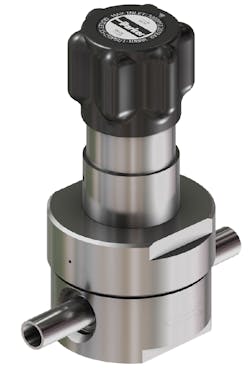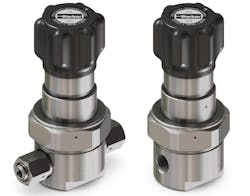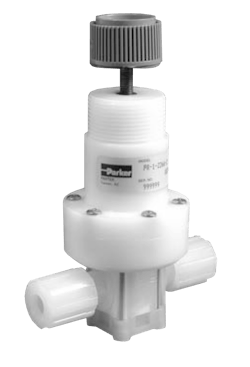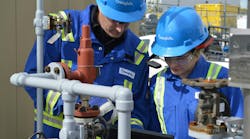High purity applications are extremely sensitive to any type of contamination, including particles present in the air (moisture, oxygen and other gases). Unlike other applications which are more equipped to handle a contaminant being introduced and filtered out downstream, the introduction of a contaminant in a manufacturing process could be detrimental to the downstream equipment. If ignored, this can and likely will lead to unscheduled downtime and, in some cases, millions of dollars in revenue on hold as a result. Thus, a regulator’s construction and performance can have just as much of an impact as the process conditions needed to size the regulator. In fact, this discussion will focus directly on these three, most impactful elements when specifying a regulator: process conditions, regulator construction and regulator performance.
Process conditions
There are five key process determinations to consider:
- Temperature
- Media
- End connections
- Pressure (inlet and desired outlet)
- Flow
The first consideration is temperature where the specification mainly corresponds to the elastomer seals within the regulator. Because they are a “softer” material, the elastomer materials can deform at higher temperatures. It is important to consult literature on the seat materials to confirm it is suitable for the temperature range of the process. Otherwise, failure in the seals can cause leaking, resulting in safety hazards.
Next, one must understand the media. The main element to consider with the media flowing through the process is its compatibility with all materials it encounters. This includes the regulator body material as well as any seals within the body. Chemical compatibility of the media and all materials must be taken into consideration to avoid leaking and safety hazards.
The end connections must also be a part of the conversation. Applications generally call for metal-metal face seal or tube-end connections to minimize the probability of leaking across the seal. NPT connections should be avoided to minimize particles contaminating the stream by the screwing connection.
Pressure concerns are typically subcategorized into inlet and outlet. A main consideration for inlet pressure is the supply pressure effect (SPE). This phenomena happens as a result of an internal force balance occurring inside the regulator. The effect on the regulator performance is a pressure rise. In fact, most manufacturer literature will list a given outlet pressure rise per 100 psi decrease in supply pressure.
If SPE is a concern for an application — such as selecting a regulator to use at the gas supply source — the use of a two-stage regulator over a single-stage regulator can minimize the effect. However, this approach should only be considered on a case-by-case basis as the two-stage regulator typically also increases droop, which may not be favorable depending on the application.
Outlet pressure is determined by the range spring used inside the body. Manufacturers will typically list these pressure ranges to assist in selection. In general, the heavier the spring, the higher the outlet pressure range.
Finally, there is the issue of flow. The Cv spec of a regulator is representative of the flow through the regulator at its fully open state. This is particularly significant as regulator Cv considerations are different than valve Cv considerations. Valves are generally fully opened or fully closed, and therefore the Cv callout is directly related to sizing the appropriate valve. However, regulators are rarely used in their fully open state, which is why it is critical to check with the manufacturer provided flow curve to verify the flow range for the application is appropriate for the regulator in question.
Regulator construction
For media compatible with stainless-steel/metal-alloy manufactured regulators, there are two main manufacturing processes: forged and bar stock construction.
Ultra-high pressure applications should use a bar stock constructed body. The material is less porous and lessens the risk of entrapment of contaminants. Furthermore, the bar stock construction machining process allows for a smoother finish which reduces the risk of shedding into process stream.
For more corrosive applications, it may be appropriate to use a polymer body. Generally, PTFE/PFA material is used if a stainless-steel material is non-compatible with the process media.
The role of the diaphragm is another element of great importance regarding a regulator. There are manufacturers who understand this importance and use Hastelloy (C276 Alloy) material for its construction. Compared to other alloys, it is highly corrosive-resistant, making it a reliable choice and high value option in terms of the regulator’s longevity.
Stainless-steel diaphragm valves are also appropriate for these applications as they do not off-gas (absorb and release) contaminants. Elastomers should not be considered for this reason. They will introduce contaminants into the process through off-gassing.
Regulator performance
Droop is a known phenomenon that results in a decrease in outlet pressure as the flow increases through a regulator. It is primarily caused by the load spring and the resulting forces changing within the regulator.
In order to manage droop, there are a few strategies to consider. One such solution is to choose a regulator where the inlet pressure is as close to the actual system pressure as possible. This results in a more controlled change in pressure as the handle is turned/regulator is operated. Next, it is a sound tactic to evaluate how the desired pressure specifications compare to a published flow curve provided by the manufacturer. If it falls within the ideal operating pressure area, then it is appropriate for use in that application. Appropriately taking droop into consideration can avoid choked flow through the regulator.
Selecting a regulator is not a simple process. There are many application specific elements to consider and critical ramifications associated with each decision. The most important takeaway is to always consult with an expert that has experience specifying regulators for similar applications.
Ashley Raimondi is an inside account manager with Valin Corporation, a leading technical solutions provider for the technology, energy, life sciences, natural resources and transportation industries. Valin offers personalized order management, on-site field support, comprehensive training and applied expert engineering services utilizing automation, fluid management, precision measurement, process heating, and filtration products. For more information, please visit https://www.valin.com.




